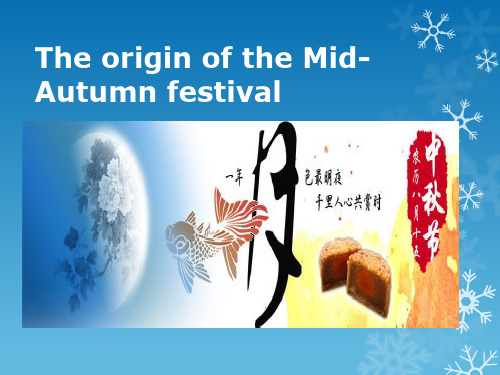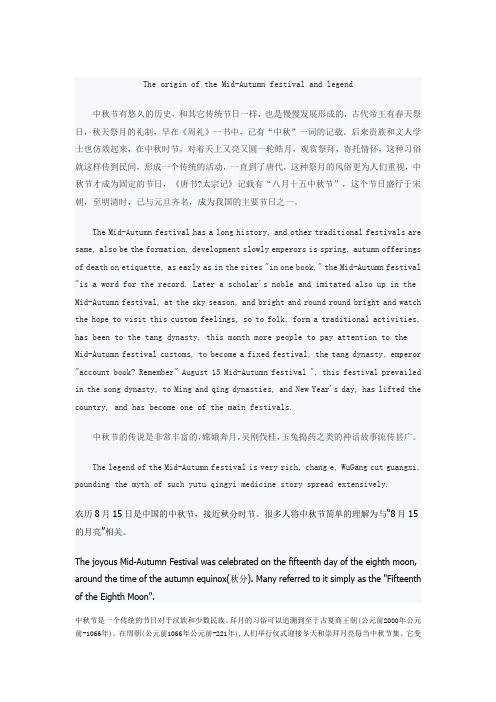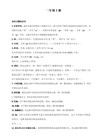the origin of mid-autumn day
- 格式:ppt
- 大小:1.37 MB
- 文档页数:7




The origin of the Mid-Autumn festival and legend中秋节有悠久的历史,和其它传统节日一样,也是慢慢发展形成的,古代帝王有春天祭日,秋天祭月的礼制,早在《周礼》一书中,已有“中秋”一词的记载。
后来贵族和文人学士也仿效起来,在中秋时节,对着天上又亮又圆一轮皓月,观赏祭拜,寄托情怀,这种习俗就这样传到民间,形成一个传统的活动,一直到了唐代,这种祭月的风俗更为人们重视,中秋节才成为固定的节日,《唐书?太宗记》记载有“八月十五中秋节”,这个节日盛行于宋朝,至明清时,已与元旦齐名,成为我国的主要节日之一。
The Mid-Autumn festival has a long history, and other traditional festivals are same, also be the formation, development slowly emperors is spring, autumn offerings of death on etiquette, as early as in the rites "in one book," the Mid-Autumn festival "is a word for the record. Later a scholar's noble and imitated also up in the Mid-Autumn festival, at the sky season, and bright and round round bright and watch the hope to visit this custom feelings, so to folk, form a traditional activities, has been to the tang dynasty, this month more people to pay attention to the Mid-Autumn festival customs, to become a fixed festival, the tang dynasty, emperor "account book? Remember" August 15 Mid-Autumn festival ", this festival prevailed in the song dynasty, to Ming and qing dynasties, and New Year's day, has lifted the country, and has become one of the main festivals.中秋节的传说是非常丰富的,嫦娥奔月,吴刚伐桂,玉兔捣药之类的神话故事流传甚广。

mid-autumn dayMid-Autumn Day: A Traditional Chinese Festival Celebrating Family and HarvestIntroductionMid-Autumn Day, also known as the Moon Festival, is a traditional Chinese festival celebrated on the 15th day of the eighth lunar month. It is one of the most important holidays in Chinese culture and holds great significance for both the Chinese people and Chinese diaspora around the world. This annual celebration is marked by various customs and traditions, including moon gazing, lantern festivals, and the consumption of mooncakes. In this article, we will explore the origins of Mid-Autumn Day, its cultural significance, and how it is celebrated today.Historical OriginsThe origins of Mid-Autumn Day can be traced back over3,000 years to the Shang Dynasty in ancient China. This festival was initially associated with the worship of the moon and the celebration of the autumn harvest. The festivalgained popularity during the Tang Dynasty and continued to be celebrated throughout the following dynasties. Mid-Autumn Day became an opportunity for families to gather and express gratitude for the bountiful harvest while praying for good fortune and harmony.Cultural SignificanceMid-Autumn Day holds profound cultural and symbolic significance for the Chinese people. The festival is seen as a time to honor family relationships and express gratitude. The full moon is considered a symbol of reunion and completeness, and it is believed that on this day, the moon is at its fullest and brightest. Many Chinese people use this festival as an occasion to express their love and affection for their family members who may be living far away.Celebrations and CustomsMid-Autumn Day is celebrated with several customs and traditions. Mooncakes, a type of pastry filled with sweet or savory fillings, are a quintessential part of the festival. These delicacies are often shared among family members and exchanged as gifts with loved ones. The round shape of the mooncakes represents completeness and reunion. Anotherpopular tradition is moon gazing, where people gather outdoors to admire the beauty of the full moon. Lantern festivals are also held, with elaborate lantern displays and parades attracting thousands of visitors.Family ReunionsMid-Autumn Day is a time when families come together to celebrate. Many people make an effort to travel back to their hometowns to spend time with their loved ones. The festive atmosphere during this holiday is filled with laughter, warmth, and joy. Family members exchange gifts and share meals, usually featuring an array of delicious dishes and traditional foods. It is common for elderly family members to tell stories and impart wisdom to the younger generations during these reunions.Symbolism and FolkloreThe moon features prominently in the symbolism and folklore associated with Mid-Autumn Day. The ancient Chinese believed that the goddess Chang'e resided on the moon and that her beauty was enhanced during the Mid-Autumn Festival. The story of Chang'e and her husband Houyi, a skilled archer, is often retold during this festival.According to the legend, Houyi shot down nine of the ten suns that were scorching the Earth and was rewarded with the elixir of immortality. However, fearing its misuse, Chang'e consumed the elixir and ascended to the moon, where she remains to this day.Modern CelebrationsToday, Mid-Autumn Day is celebrated not only in China but also in many other countries with a significant Chinese population. The festival has evolved with time, incorporating new elements while preserving its traditional essence. In addition to traditional customs, modern celebrations often include cultural performances, music, and dance. Mooncake-making competitions, lantern-making workshops, and lantern riddle games are organized to engage people of all ages.ConclusionMid-Autumn Day is a cherished festival that brings together families, celebrates the harvest, and pays homage to the moon. Its rich history and cultural significance continue to resonate with the Chinese people, serving as a reminder of the importance of family unity and gratitude. This festival not only strengthens family bonds but also promotes culturaldiversity by showcasing the unique traditions and customs of the Chinese community. As Mid-Autumn Day approaches each year, Chinese households and communities eagerly anticipate the celebrations, eagerly waiting to reconnect with family and friends, and honor their heritage.。

中秋节的来历的英语翻译The Origin and History of the Mid-Autumn FestivalThe Mid-Autumn Festival, also known as the Moon Festival, is one of the most important traditional Chinese festivals. It falls on the 15th day of the eighth month in the Chinese lunar calendar, which usually corresponds to September or October in the Gregorian calendar. The festival is celebrated by Chinese people worldwide, and it has a history of more than 3,000 years.The origin of the Mid-Autumn Festival can be traced back to ancient China. According to legend, during the Shang Dynasty (1600-1046 BC), a beautiful lady named Chang'e swallowed an elixir of immortality and ascended to the moon, living there as a lunar deity. Her husband, Houyi, was a skilled archer who shot down nine suns to save the earth. He was rewarded with an elixir of immortality, but he chose not to take it and wanted to save it for future use. However, his apprentice, Peng Meng, broke into their house and tried to steal the elixir when Houyi was out. Fearing that Peng Meng would succeed, Chang'e decided to drink the elixir herself and flew to the moon, where she has lived ever since. Another popular legend associated with the Mid-Autumn Festival is the story of a rebellion against the Mongol-led Yuan Dynasty in the 14th century. The Han Chinese people's desire for freedom and unity was symbolized by mooncakes, which were used as means of communication. Messages hidden inside mooncakes allowed the Han Chinese to coordinate their uprising on the 15th day of the eighth lunar month, leading to the success of the rebellion that eventually established the Ming Dynasty.Traditionally, the Mid-Autumn Festival is a time for family reunion. People would gather to appreciate the full moon, which symbolizes unity and completeness. They would participate in various activities such as lantern parades, dragon and lion dances, and folk performances. Mooncakes, a type of round pastry filled with sweet fillings like lotus seed paste or red bean paste, are an iconic food during the festival. The mooncakes are usually shared among family members and friends as a way to express good wishes and blessings for a harmonious life.In recent years, the Mid-Autumn Festival has become popular not only among Chinese communities but also among people from different cultural backgrounds. Its significance of family reunion and cultural heritage has resonated with people worldwide. The festival showcases the beauty of Chinese culture through its legends, customs, and festive atmosphere.In conclusion, the Mid-Autumn Festival is a significant Chinese festival with a rich history and legends associated with it. It is a time for family reunion, celebrating unity, and appreciating the full moon. The festival has become an important part of Chinese cultural heritage and is now gaining recognition and appreciation globally.。
【英语作文】中秋节 Mid autumn Day中秋节是中国传统节日之一,一般在农历八月十五日。
此时天气适宜,由于农作物收获,故称为“中秋节”。
中秋节的习俗十分丰富多样,其中最具代表性的要数吃月饼和赏月了。
吃月饼已成为了中秋节的重要习俗之一。
月饼是一种传统的糕点,一般由皮、馅两部分组成。
最常见的馅料是莲蓉、豆沙、五仁以及其他的水果和干果等。
此外,有些人还喜欢吃鸡蛋黄或咸蛋黄作为馅料的月饼。
随着时代的变迁,月饼的形状和种类也不断改变,但是吃月饼的习俗却一直延续至今,成为了中秋节不可或缺的一部分。
赏月也是中秋节的重要习俗之一。
在此时赏月,是由于中秋节这个时期的月亮比较圆、明、大,珍珠般的月光会映照在人们的心头,让人感到一种美好的情绪,因此,中国人也把中秋节称为“月夕”或“月夜”。
赏月的活动有时会和赏花活动结合在一起,或者会在赏月的同时燃放烟花,增添了节日的气氛。
中秋节还有一项重要的文化活动,那就是民间传说的祭月。
中国人素来有祖先崇拜的传统,故而一些人在中秋节会向月亮叩头或者向月亮祈福有个好的收成以及好的运势。
中秋祭月的习俗,最初源于古代(东汉时期)的射箭节。
据说,汉武帝以这个节日来激励出色的弓箭手们,也为身处陌生土地的将士增添一份思乡之情。
除了以上富有特色的活动之外,中秋节在文化内涵也是十分丰富的,因此,让我们一起来了解一下中国人在中秋节期间喜欢唱的歌曲:1.《月光女神》(The Moonlight Goddess)是一首以描写月亮为主题的曲子,歌颂月亮美丽的外表和其背后的故事。
2.《踏古》是中国古代音乐中的一首名曲,也常常与中秋节结合在一起演奏。
这首音乐的节奏缓慢而优美,具有很高的艺术欣赏价值。
3.《对酒当歌》是一首宋代著名诗人苏轼创作的诗歌,也成为了中秋节的代表歌曲。
总之,中秋节是中国传统文化的重要节日之一,吃月饼、赏月以及祭月等习俗,都是这个节日不可分割的一部分。
同时,中秋节也是表达亲情团聚、思乡情怀、吉祥幸福等美好情感的时刻。
中秋节由来英语作文Title: The Origin of the Mid-Autumn Festival。
The Mid-Autumn Festival, also known as the Moon Festival, is a traditional Chinese festival celebrated on the 15th day of the 8th month of the lunar calendar. It holds a significant place in Chinese culture and is a time for family reunions, appreciation of the full moon, and enjoying delicious mooncakes. But what is the origin ofthis beloved festival?Legend has it that the Mid-Autumn Festival originated from ancient China during the Tang Dynasty (618-907 AD). One of the most popular legends associated with thefestival is the story of Chang'e, the Moon Goddess.According to the legend, there were ten suns in the sky, scorching the earth and causing great suffering to the people. Hou Yi, a skilled archer, was tasked with shooting down nine of the suns by the Jade Emperor as a reward forhis bravery. With precise aim, Hou Yi successfully shot down nine suns, saving the earth from destruction and earning the admiration of the people.As a token of gratitude, the Queen Mother of the West gave Hou Yi an elixir of immortality. However, knowing that immortality would separate him from his beloved wife, Chang'e, Hou Yi hid the elixir at home. One day, while Hou Yi was away hunting, Peng Meng, a jealous apprentice of Hou Yi, attempted to force Chang'e to give him the elixir. Realizing she couldn't let Peng Meng take the elixir, Chang'e consumed it herself and, as a result, ascended to the moon, becoming the Moon Goddess.When Hou Yi returned home and learned of what had happened, he was devastated. To express his love and longing for Chang'e, he would offer her favorite foods and fruits during the Mid-Autumn Festival. Over time, people began to follow Hou Yi's example, offering sacrifices to Chang'e and praying for happiness and good fortune.Another popular legend associated with the Mid-AutumnFestival is the story of Wu Gang and the Cherry Bay. Wu Gang, a woodcutter, was punished by the Jade Emperor to cut down the self-healing cherry bay tree on the moon as a penance for his wrongdoing. However, every time Wu Gang chopped down the tree, it would miraculously grow back, prolonging his punishment for eternity. This legend symbolizes perseverance and the pursuit of self-improvement.Throughout history, the Mid-Autumn Festival has evolved into a celebration of harvest, unity, and familial love. Families gather to admire the full moon, eat mooncakes, and share stories passed down through generations. Lanterns are lit, dragon dances are performed, and the air is filledwith laughter and joy.In modern times, the Mid-Autumn Festival remains one of the most cherished festivals in Chinese culture, celebrated not only in China but also in many other countries with Chinese communities. It serves as a reminder of the importance of family, tradition, and gratitude in an ever-changing world.In conclusion, the Mid-Autumn Festival is deeply rooted in Chinese folklore and tradition, with legends like that of Chang'e and Wu Gang contributing to its rich cultural significance. As we gather with our loved ones under the glow of the full moon, let us remember the stories of old and the values they teach us: love, sacrifice, and the enduring power of hope. Happy Mid-Autumn Festival!。
中秋节的由来赏月吃月饼的意义英语作文The Origin of Mid-Autumn Festival: The Meaning of Admiring the Moon and Eating MooncakesMid-Autumn Festival, also known as Moon Festival or Chinese Lantern Festival, is one of the most important traditional festivals in China. It falls on the 15th day of the eighth lunar month, when the moon is believed to be at its fullest and brightest. On this special occasion, family members gather together to enjoy a festive meal, admire the moon's beauty, and indulge in delicious mooncakes.The origin of Mid-Autumn Festival can be traced back thousands of years to ancient China. Legend has it that during the Western Zhou Dynasty (1046-771 BC), there were ten suns in the sky that caused severe droughts and brought devastation to crops. To save humanity from this disaster, a skilled archer named Hou Yi shot down nine of the suns with his bow and arrow. In gratitude for his heroic act, the Queen Mother of Heaven presented him with an elixirthat could grant immortality.Hou Yi loved his wife Chang'e deeply and wanted her to have eternal life as well. However, he was aware that sharinghalf of the elixir's power would only bring them both suffering. Thus, he entrusted the elixir to Chang'e for safekeeping. Unfortunately, their apprentice Peng Meng discovered this secret and tried to steal it when Hou Yiwas away. Faced with no other choice, Chang'e swallowed all of the elixir herself.Upon consuming it, Chang'e felt weightless and began tofloat towards heaven. She landed on the moon without being able to return to Earth ever again. From then on, people started worshipping her as a lunar deity during Mid-Autumn Festival.Admiring the moon is an important tradition during Mid-Autumn Festival as it symbolizes family reunion and harmony. On this night, families sit together in open spaces, suchas parks or rooftops, to appreciate the full moon's radiance. Lanterns are also hung around houses and streets, adding a touch of magic to the atmosphere. The moonrepresents unity and completeness, reminding people oftheir loved ones who may be far away during this festival. It serves as a beacon of hope and connection between family members near and far.Mooncakes are another significant part of Mid-Autumn Festival. These round pastries come in various flavors and fillings, such as lotus seed paste, red bean paste, or salted egg yolk. The round shape of mooncakes symbolizes the reunion of families. They are often exchanged as gifts between friends and relatives during this festive season.In addition to their symbolic meaning, mooncakes are a culinary delight that demonstrate Chinese craftsmanship. They require meticulous preparation and intricate designs on their surface. Mooncakes not only cater to the taste buds but also serve as a cultural representation of Chinese tradition.To conclude, the Mid-Autumn Festival is not just about admiring the moon or devouring mooncakes; it carries profound historical significance and cultural value. Thelegend behind its origin reminds us of bravery, sacrifice, love, and unity. It's a time for families to come together, show gratitude for harvest blessings, express love through gift-giving, and cherish the moments under the gentle glow of the moonlight.。